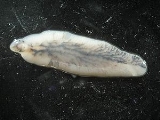
Fasciolidae
Encyclopedia
Fasciolidae is a family of trematodes and includes several veterinary and medical important parasites. Family Fasciolidae is divided into 5 genera
. Flukes of the family are localized in liver
, gall bladder, and the intestine
. The life cycle of fasciolid flukes includes one intermediate host
– freshwater snail
s from family Lymnaeidae
.
Genus
In biology, a genus is a low-level taxonomic rank used in the biological classification of living and fossil organisms, which is an example of definition by genus and differentia...
. Flukes of the family are localized in liver
Liver
The liver is a vital organ present in vertebrates and some other animals. It has a wide range of functions, including detoxification, protein synthesis, and production of biochemicals necessary for digestion...
, gall bladder, and the intestine
Intestine
In human anatomy, the intestine is the segment of the alimentary canal extending from the pyloric sphincter of the stomach to the anus and, in humans and other mammals, consists of two segments, the small intestine and the large intestine...
. The life cycle of fasciolid flukes includes one intermediate host
Intermediate host
A secondary host or intermediate host is a host that harbors the parasite only for a short transition period, during which some developmental stage is completed. For trypanosomes, the cause of sleeping sickness, humans are the primary host, while the tsetse fly is the secondary host...
– freshwater snail
Snail
Snail is a common name applied to most of the members of the molluscan class Gastropoda that have coiled shells in the adult stage. When the word is used in its most general sense, it includes sea snails, land snails and freshwater snails. The word snail without any qualifier is however more often...
s from family Lymnaeidae
Lymnaeidae
Lymnaeidae is a taxonomic family of small to large air-breathing freshwater snails, aquatic pulmonate gastropod mollusks, that belong to the clade Hygrophila....
.
Morphological features
- length of adults: 2 (Parafasciolopsis) up to 10 cm (Fasciola gigantica, Fascioloides magna)
- suckers: oral and ventral sucker are closely located
- cercariae: gymnocephalic shape
Systematics within family
According to Olson et al. 2003 the family has five genera:- Fasciola
- F. hepaticaFasciola hepaticaFasciola hepatica, also known as the common liver fluke or sheep liver fluke, is a parasitic flatworm of the class Trematoda, phylum Platyhelminthes that infects the livers of various mammals, including humans. The disease caused by the fluke is called fascioliasis . F...
– Common liver fluke - F. giganticaFasciola giganticaFasciola gigantica is a parasitic flatworm of the class Trematoda, which causes tropical fascioliasis. It is regarded as one of the most important single platyhelminth infections of ruminants in Asia and Africa...
- F. jacksoni
- Fasciola spp. – Japanese strain
- F. hepatica
- Fascioloides
- F. magnaFascioloides magnaFascioloides magna, also known as giant liver fluke, large American liver fluke or deer fluke, is an important parasite of a variety of wild and domestic ruminants in North America and Europe. Adult flukes occur in the liver of the definitive host and feed on blood...
- F. magna
- FasciolopsisFasciolopsisFasciolopsis is a genus of trematodes. It consists only of two species, F. buski and F. Magna, of which, F. buski, is more notable in terms of prevalence and pathogenicity as it causes the disease fasciolopsiasis.-Fasciolopsis buski:...
- F. buski
- Parafasciolopsis
- P. fasciolaemorpha
- Protofasciola
- P. robusta

